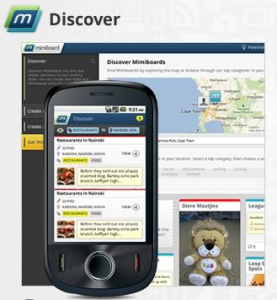Mimiboard Replacing Noticeboards in Africa | Interview with Johan Nel Founder
 Mimiboard, virtual, 3.0 version notice boards are disrupting publishing and news content aggregation in Africa, influencing even how media houses on the continent relay news.
Mimiboard, virtual, 3.0 version notice boards are disrupting publishing and news content aggregation in Africa, influencing even how media houses on the continent relay news.
Johan Nel, CEO and founder of Umuntu Media says,” Mimiboards will help people on the continent record and handle issues live as they emerge. The virtual notice boards can be shared by a group, community, campus, institution or even media house and they post issues to it like they could on a traditional wooden notice board.”
On Umuntu Media’s portal, the firm says, “Africa has over a billion people but with just one registered domain per 10,000 people, it is a continent crying out for local content. We are bridging that gap, using technology to directly connect people who want to know what’s going on in their area, all day, every day.” The reason the firm says inspired it to design Mimiboards; adding to its passion for Africa, love of technology and being into local content.
The Mimiboard beat ten other apps from Africa to be the best at the App demo competition held at the Nairobi Open Innovation Summit in May.
At the moment, the firm is partnering with several media houses to use Mimiboards to unveil local content across the continent.
TechZulu caught up with Johan Nel, Founder and CEO.
What is a Mimiboard?
First of all, the meaning – Mimi means “I” in Swahili, so think of it as “MY” board. A Mimiboard is best described as a traditional noticeboard. We realised that noticeboards still play a pivotal role within any community across the globe, and we took this very successful concept and made it virtual.
What does a Mimiboard do?
Referencing the traditional noticeboard concept, you start by creating a Mimiboard using a location, could be an area, town, street name. Then you assign certain categories to it. The methods of adding notes to this board are quite vast. People can now add notes to the board – using Twitter, SMS, Rich web, WAP, Android and Java supported devices. People could add notes regarding whatever the category selection of the board determines. For example, goods for sale – people add items that are for sale, their contact details, images of the product. Now that there is activity happening on this board – the board creator can do a few things with it. Using our quick export function – he can embed this on a website or facebook page. Print it out as a community or classifieds newspaper or display at as a realtime data feed on a monitor. So imagine you are a Radio Station- now for the first time you can create and sustain a community conversation on your website – which will increase your traffic on your website and provide a very innovative platform for your users. This is merely one example on how to use it.
Are Mimiboards important in Africa?
We certainly feel that it is extremely important. There is a gap between Publishers and their users. With Mimiboard, we aim to bridge that gap. Content generation from the ground up is something that is not being done properly. Location based advertising and marketing is something that’s been attempted but not yet perfected. With Mimiboard, its possible.
To media and civil rights what does Mimiboards mean?
For Media companies – this could be huge. As mentioned above, they will now be able to leverage their audience and obtain ground level user generated news. Quicker and more effectively than any of their competitors.
Regarding Civil Rights – I don’t think we are dramatically changing this, I think we could rather improve it, as we add an additional platform for users to voice concerns and opinions.
On a global scale, do Mimiboards solve anything?
The world is still completely Community orientated. There are communities everywhere. Neighbourhoods, Sport Clubs, Religion, etc. Mimiboard has an important role to play wherever communications needs to happen within a community. So yes, we definitely think that it can provide solutions to these groups.
Who are the founders, investors, mentors behind the Mimiboard?
The holding company behind Mimiboard is Umuntu Media. (www.umuntumedia.com). I am the founder , Investors are Eva Fund. Johan also came up with the original concept for Mimiboard. There are also a few influencers in the Product lifecycle.
Any funding yet, how much?
Umuntu received funding in September 2011 – the amount was approx. US $1 million from Eva Fund.
How many boards so far? Do users pay?
Approx about 250 boards have been created thus far. In terms of views of those boards, Approx about 75000. We are not charging for the use of boards yet.
What’s the business model?
We will adopt the Software as a Service model, where we will have a Free version and a Paid for version. So people will pay for certain added functionality on the boards. This will be a monthly fee. We will also incorporate an advertising model where we will share revenue with the board owner.
What should we expect from Mimiboard in the future?
The next phase is going to be extremely exciting. We are completing the Advertising model, where board owners can actually make some money. We are completing the full 360 degree experience, from Profile page to Advertising and paying for the service per month. There will also be some additional UX changes that will be incorporated soon. We are aiming for official Go Live mid-October.








